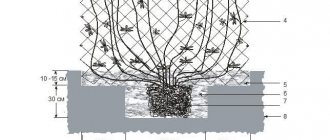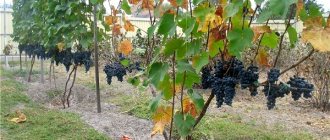Define characteristics
|
The fruits of wild grapes are small, have a tart-sour taste and are not used for food.
Vinegar, medicinal decoctions, and wine tinctures are prepared from them. Advantages:
- Rapid growth (1.5–4 m per season).
- Unpretentiousness to soil and lighting.
- Resistance to pests and diseases.
- Does not freeze in harsh winters.
- Does not require fertilizing.
- Easily propagated.
- It is a natural protection against wind, dust and precipitation.
- Creates a picturesque view
Flaws:
- In limited spaces, a shaping haircut is required (4–5 times per summer).
- The need to construct supports.
- Without control, it can quickly seize neighboring territories.
- Powerful roots go far to the sides and oppress neighboring plantings.
- Unsightly appearance in spring. The buds open slowly - it stands with bare stems until the end of May.
- Liana growing on the facade can penetrate under the roof and destroy it
Advantages and Disadvantages of Culture
Most gardeners agree that there is simply no better perennial for garden design than parthenocissus, but there is also the opposite opinion. Let's look at the pros and cons of virgin ivy.
Advantages:
- unpretentiousness, low requirements for soil and care;
- rapid growth, high degree of decorativeness;
- the ability to protect the area from dust, noise, prying eyes, rain and wind;
- the ability to create shading, protect housing from overheating, and reduce humidity levels;
- easy reproduction, possibility of wintering without shelter, strong immunity.
Ivy has much fewer disadvantages, but they can also play a role. If the support is not strong enough, a lush carpet may collapse under its own weight. The growth easily destroys soft and fragile materials, clogs gutters, and creates strong shading. Proper growth adjustment and pruning help combat these problems.
A powerful root system grows several meters from the bush, capturing the territory of other inhabitants of the garden. Neighbors are unlikely to survive the struggle for space and food; even weeds cannot do this.
Know the types of virgin grapes
Of the 10 varieties of wild grapes, two grow in our country: ivy (tripointed) and Virginia (five-leafed).
- Ivy-shaped or tripointed . It has a great resemblance to ivy. Capable of growing vertically and horizontally as ground cover. Based on the color of the foliage, it is divided into 3 varieties: Vicha/orange grapes; purple; golden. Ivy varieties lead in growth speed. Over the course of a year, the stem increases by 3–4 m.
Ivy variety. Photo: obustroeno.com
- Five-leafed or Virginian . Refers to the most unpretentious species. The oblong leaves are located on long petioles (10–20 cm). The stems can rise up to 15 m, the annual growth is 200–300 cm. It grows anywhere, but it is more beautiful and fast-growing in shady places.
The Virginia leaf consists of five separate plates attached to the petiole. Photo: ogorod-bez-hlopot.ru To give the desired shape to wild grapes, you need to regularly cut, guide, tie up the stems, block growth, and remove excess shoots.
Making a fence
Propagating virgin grapes is a fascinating process; you just need to take care of the plant and trim it in time, giving it a beautiful shape. In response to the care, the plant will thank its owner with a gorgeous view at the dacha.
Maiden grapes are also used to create hedges. In spring, the plant actively produces shoots and already becomes a lush wall. The grapes will remain in this spectacular form until late autumn, and therefore there is six months to enjoy the juicy appearance of the plant. A hedge of virgin grapes is a good way to isolate yourself from your neighbors. In addition, the plant allows you to create any shape, and this is a great opportunity for landscape design.
After wintering, the plant recovers again and takes on a gorgeous appearance. A hedge will delight the eye for many years. The plant is capable of covering a large area in a year, its vines grow quickly.
To create such a hedge, all you need is a small support and the direction of growth in the desired direction. Then you will only need to adjust the shoots as they grow. And you need to be prepared for the fact that the grapes actively produce new shoots after pruning. To control the wildness of the plant, you need to trim it regularly. But you need to remember that the plant cannot be cut in winter, especially in dried out places. The consequences may be irreversible for the grapes.
Know how to propagate correctly: 3 ways
There are three ways to propagate wild grapes: cuttings, suckers, layering. All of them are simple and do not require special skill. If the rules are followed, the survival rate is 100%. The time of the event does not matter - Parthenocissus is quite tenacious. You can propagate from spring to autumn, it is important to give it the opportunity to take root before frost.
- Cuttings of girl's grapes
Growing from cuttings is considered the most productive method for producing a large number of new plants. Held in spring and summer. Propagation by cuttings has several tricks:
| Choosing cuttings in spring For propagation, last year's woody shoot is taken. The pruning shears cut off the entire lash or the part on which there is a knot. In the internode there is a thickening and tendrils - the rudiments of roots. The cut vine is divided into cuttings with 3–4 nodes | |
| Choosing cuttings in summer A section of last year's shoot with young growth is used. Lateral processes (2–3 pieces) emerge from one bud. This option produces a dense seedling from which several shoots will begin to grow. The end of the woody shoot should be at least 5 cm and have 1–2 root buds in the form of a growth or tendril. The longer the cutting, the stronger the seedling. A 30 cm cutting will give dense growth | |
| Rooting in water Root formation occurs quickly in any conditions. You can use a container of water for this. The leaves at the bottom of the branch are removed. Water should cover no more than 5 cm of the cutting. When transplanted into the ground, the water roots die off and permanent roots appear in their place. Adaptation is painless and quick | |
| Rooting in the ground Parthenocissus gives excellent roots in the ground. If you have not decided on a place for planting, use cups for seedlings. It is advisable to choose a high container, at least 10 cm. Deepen the short cutting by 5 cm, and the long cutting (15–20 cm) to the middle. Keep the soil moist, roots will appear in 8-10 days. Many people root in a permanent place or in a growing strip-bed, where the seedlings can be left until the next season |
I recommend planting it in the ground immediately. The water method is used if you do not have the opportunity to immediately plant in the ground.
- Layerings
The most popular method of vegetative propagation of grapes is rooting cuttings. The method is simple and does not require any manipulation. The liana quickly produces roots upon contact with the ground.
You can speed up the process by deepening or pressing. A strong whip is selected and placed in a free space, near the mother bush. Pinned or lowered into a shallow groove (5 cm).
Try not to twist the stem or tear it off from the main trunk. Photo: nasotke.pro
The cuttings are not buried; the stem and leaves remain on the surface. In these places between the internodes, strengthen the contact, place stones on the branch or use garden pins.
If the manipulation with germination of layering was carried out at the beginning of June, then at the end of August the seedling is ready. Before planting in another place, cut off the shoot from the main branch with pruning shears.
To obtain several plants, the long, rooted stem can be divided, leaving 1–2 internodes. Each part is dug out with a shovel, with a lump of earth.
Often the cuttings are not touched until the next season. In this case, you will have powerful bushes that will quickly grow.
- Offspring
Parthenocissus forms shoots - root shoots called suckers. In this case, you just need to dig up new bushes and plant them in the right place.
The operation is performed using a shovel in the summer (from May to August). The root shoot is cut off from the mother plant, and the seedling is transferred to a new location with a lump of earth.
A scion is a young plant with a strong root system ready for replanting. Photo: i1.wp.com
Root the grapes
How to root grapes? The best soil for rooting is loose, breathable, fertile. Shoots and cuttings quickly form roots in it. The stem is buried, reclining or at an angle - this will increase the volume of the root system. At least two buds remain above the surface.
For the first 10 days, you need to ensure regular watering - soil moisture affects the activation of root formation. It is advisable to immediately build a support: drive in guides or deepen iron pegs for tying the lashes. In a month, your seedling will take root and produce its first shoots.
Rooting in cups is carried out if it is not possible to plant outside. It is better to root immediately in open ground.
Plant wild grapes
When planting purchased or your own seedlings, you should follow the planting deadlines. Plants grown in a container can be planted at any time until September. Rooted cuttings do not take root well in the July heat, but if watering is provided, planting will be successful.
It is better to plant in the fall, since it is already cool and the soil is moistened by rain. In spring, such seedlings quickly grow. In the Moscow region, the period lasts until mid-October. I offer step-by-step instructions.
- Selecting a location
The longevity of the vine requires taking the choice of location seriously. You can plant it on any site. In the sun, survival rate is worse; the bush begins to actively grow only after 2–3 years. In a shady, semi-shady place, the plant will quickly take root and produce large shoots in the second year.
If you want to decorate a fence, gazebo, pergola, or arch, take into account the volume of an adult plant. The thickness of the plane, with regular pruning, will be 50–70 cm. When planting near a building, you should step back 1 meter from the foundation and immediately install guides.
- Landing
The interval between plants is maintained at 80–100 cm. If you want to get a thick mass of greenery in a short time, the distance is reduced to 50 cm. Having marked the place for the holes, dig a hole of 15–20 cm, pour fertile soil (humus, compost) into it.
When planting, deepen the root collar by 3–5 cm. Mulch the planting circle or cover it with peat and water it. For the first 3-4 days, make a sun screen or cover it with non-fabric. Keep the soil moist. In the first year, weed the planting site.
Best time to breed
Autumn planting allows the plant to extend the growing season.
And if the temperature regime turns out to be favorable, the seedling will begin to develop early. And you won’t have to look for a place to store cuttings, which is also important. The best time for planting is September - October.
The best time to plant seedlings in the ground is September-October.
“Green Hedge” will serve you for decades, forming a sufficient amount of foliage to cover large areas. One vine grows up to four meters in length per year. This means that the formation of bushes should be started immediately so as not to neglect the plant.
The grapes only need minimal support to begin to take over the space around them. All you have to do is make adjustments by pruning the bushes in a timely manner.
Tags: grapes, girlish, plant, cuttings
About the author: admin4ik
« Previous entry
Care
- In dry summers, watering is carried out 3-4 times per season. Water consumption: 10 l - per adult plant.
- For active growth, urea is added in the spring (2 tablespoons per m²), in August - nitroammofoska or Kemira-Universal in the same amount.
- In spring, dried branches are removed. In the summer, if necessary, a shaping haircut is carried out, removing excess lateral processes. The frequency is selected individually, depending on the landing location and functionality.
- When attacked by slugs, insecticides are used.
Details about growing and caring for wild grapes are in the video.:











